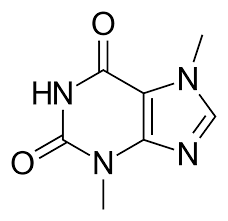Talk:Theobromine
 |
This article is a stub. As such, it may contain incomplete or wrong information. You can help by expanding it. |
| Theobromine | |||||||||||||||||||||||||||||||||
|---|---|---|---|---|---|---|---|---|---|---|---|---|---|---|---|---|---|---|---|---|---|---|---|---|---|---|---|---|---|---|---|---|---|
 |
|||||||||||||||||||||||||||||||||
| Chemical Nomenclature | |||||||||||||||||||||||||||||||||
| Common names | Theobromine | ||||||||||||||||||||||||||||||||
| Substitutive name | 3,7-dimethylxanthine | ||||||||||||||||||||||||||||||||
| Systematic name | 3,7-Dimethyl-3,7-dihydro-1H-purin-2,6-dion Name | ||||||||||||||||||||||||||||||||
| Class Membership | |||||||||||||||||||||||||||||||||
| Psychoactive class | Stimulant | ||||||||||||||||||||||||||||||||
| Chemical class | Xanthine | ||||||||||||||||||||||||||||||||
| Routes of Administration | |||||||||||||||||||||||||||||||||
|
|||||||||||||||||||||||||||||||||
https://www.ncbi.nlm.nih.gov/pmc/articles/PMC3672386/
http://www.chemspider.com/Chemical-Structure.5236.html
| Summary sheet: Theobromine |
Theobromine (3,7-dimethyl-1H-purine-2,6-dione or xantheose) is a bitter, white stimulant drug of the xanthine class that is closely related to caffeine. It is one of the main metabolites of caffeine and is the main alkaloid of theobroma cacao and its preparations: cocoa and chocolate. It is similar to caffeine in both its chemical structure and effects but weaker in its antagonism of adenosine receptors.
Subjective effects
Disclaimer: The effects listed below cite the Subjective Effect Index (SEI), an open research literature based on anecdotal user reports and the personal analyses of PsychonautWiki contributors. As a result, they should be viewed with a healthy degree of skepticism.
It is also worth noting that these effects will not necessarily occur in a predictable or reliable manner, although higher doses are more liable to induce the full spectrum of effects. Likewise, adverse effects become increasingly likely with higher doses and may include addiction, severe injury, or death ☠.
Physical effects
- Stimulation
- Frequent urination
- Vasodilation
- Bronchodilation
- Cough suppression
- Decreased blood pressure
- Increased heart rate
- Increased perspiration
- Stamina enhancement
- Tactile enhancement
Cognitive effects
Theobromine's cognitive effects are weaker than caffeine's.
- Analysis enhancement
- Anxiety
- Cognitive fatigue
- Compulsive redosing
- Cognitive euphoria
- Increased libido
- Memory enhancement
- Motivation enhancement
- Thought acceleration
- Wakefulness
Experience reports
There are currently no anecdotal reports which describe the effects of this compound within our experience index.
See also
External links
References
 |
This article does not cite enough references. You can help by adding some. |